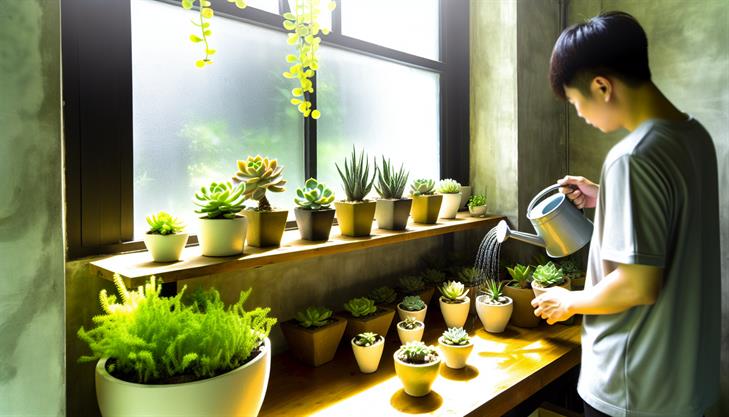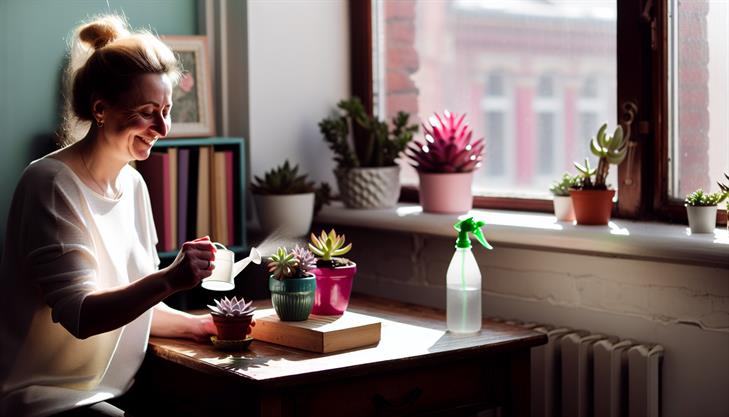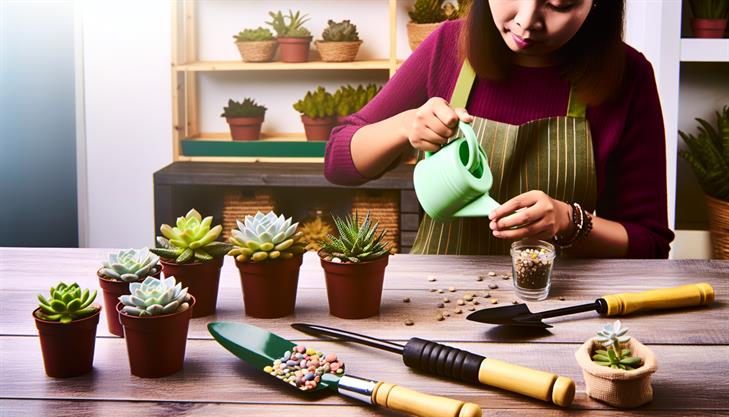In the bustling world we live in, finding a serene corner in our homes can be a sanctuary for the soul. Indoor plants, especially succulents, offer a perfect marriage of beauty and low-maintenance care, breathing life into our living spaces with their vibrant hues and unique textures. However, while these resilient plants might seem invincible, they do require a touch of know-how to truly thrive indoors. In "How to Care for Succulent Plants Indoors," we delve into the essential practices that will keep your little green companions not just surviving, but flourishing. Whether you’re a beginner looking to start your indoor garden or a seasoned plant enthusiast seeking to perfect your craft, this guide will provide invaluable insights into lighting, watering, and the ideal environment for your succulents. Join us to discover how nurturing these miniature masterpieces can transform your home into an oasis of tranquility and natural beauty.
Choosing the Right Succulents for Indoors
Caring for succulent plants indoors involves understanding their unique needs to promote healthy growth and prevent common problems. Follow these guidelines to ensure your indoor succulents thrive:
1. Select the Right Succulent:
Choosing the right succulent is the first step to care for succulent plants indoors effectively. Some indoor-friendly varieties include the Jade Plant, Aloe Vera, Echeveria, and Zebra Plant. These are well-suited for indoor conditions and are generally easier to maintain.
2. Light Requirements:
Succulents require ample sunlight to thrive. Position your plants near a south or east-facing window where they can receive bright, indirect light for at least six hours a day. If natural light is insufficient, consider using a grow light to supplement their need for illumination, which is crucial for maintaining vibrant colors and promoting growth.
3. Watering Schedule:
One of the most common issues with indoor succulents is overwatering. To care for succulent plants indoors, it’s crucial to adopt a ‘soak and dry’ method. This means allowing the soil to completely dry out between waterings. Typically, you may need to water them every one to three weeks, depending on the indoor climate. Ensure you use pots with drainage holes to prevent water from accumulating at the bottom.
4. Soil Type:
Opt for a well-draining soil mix, specifically designed for succulents and cacti. This type of soil helps prevent root rot, a common problem when caring for succulent plants indoors. You can either purchase pre-mixed succulent soil or create your own by combining potting soil, sand, and perlite in equal parts.
5. Temperature and Humidity:
Indoor succulents prefer temperatures between 60°F and 80°F (15°C to 27°C). Keep them away from cold drafts and heating vents, as sudden temperature changes can stress the plants. Although succulents can tolerate low humidity, a balanced indoor environment is beneficial.
6. Fertilization:
Fertilize your succulents sparingly to support their slow growth indoors. Use a balanced, water-soluble fertilizer diluted to half strength once a month during the growing season (spring and summer). Avoid fertilizing during the dormant period in fall and winter.
7. Pest Management:
Despite being hardy, succulents can attract pests like mealybugs and spider mites. To mitigate these issues, regularly inspect your plants, ensuring you catch infestations early. Use a cotton swab dipped in rubbing alcohol to remove pests or opt for a gentle insecticidal soap.
Additional Tips:
- Rotate your succulents periodically to ensure even exposure to light, which helps them grow symmetrically.
- Clean the leaves with a soft brush or cloth to remove dust that can hinder photosynthesis.
- Be mindful of plant signals – wrinkled leaves may indicate under-watering, while mushy leaves could mean overwatering.
By following these steps and paying attention to the specific needs of your succulents, you’ll be on the right path to mastering how to care for succulent plants indoors. Keep in mind their unique characteristics and adapt your care routine accordingly to see your indoor garden flourish.
Essential Care Tips for Healthy Indoor Succulents
Succulent plants are popular indoor gardening choices due to their unique shapes, vibrant colors, and minimal maintenance requirements. However, understanding how to care for succulent plants indoors is crucial to ensure these resilient beauties thrive in your living space. Here’s a comprehensive guide to help you nurture healthy indoor succulents.
1. Choosing the Right Container:
When selecting a container for your indoor succulents, opt for one that provides excellent drainage. Succulents do not like to sit in waterlogged soil. Hence, a pot with drainage holes is essential to prevent root rot. Terra cotta pots are ideal because their porous nature allows for better soil aeration, but any well-draining container will work.
2. Preparing the Perfect Soil:
Succulents require a well-draining soil mix. Look for specialized cactus or succulent soil mixes available at gardening stores. Alternatively, you can create your own mix by combining regular potting soil with coarse sand or perlite to enhance drainage.
3. Providing Adequate Light:
Light is crucial for indoor succulents. Most succulents prefer bright, indirect sunlight. Place your plants near south or east-facing windows where they can receive plenty of natural light. If natural light is insufficient, consider supplementing with a grow light for a few hours per day to ensure they get the light they need.
4. Watering Wisely:
Overwatering is a common issue when caring for indoor succulents. The key is to let the soil dry out completely between waterings. Depending on your climate, this could mean watering every 1-3 weeks. Water deeply but infrequently, allowing the excess to drain away—never let the pot sit in water.
5. Controlling Temperature and Humidity:
Most succulents thrive in warm temperatures, ranging from 60-80°F (15-27°C). Protect them from extreme temperatures and drafts. In terms of humidity, succulents prefer dry air; avoid placing them in very humid rooms, such as bathrooms, as excess humidity can lead to mold growth.
6. Fertilizing Sparingly:
While succulents don’t need much fertilizer, feeding them during their growing season (spring and summer) can encourage robust growth. Use a balanced, water-soluble fertilizer diluted to half strength once a month. Avoid fertilizing in the dormant winter months.
7. Addressing Common Problems:
-
Overwatering/Root Rot: Yellowing leaves and mushy stems indicate overwatering. Allow the soil to dry thoroughly, and reduce watering frequency.
-
Sunburn: Brown spots can suggest the plant is getting too much direct sunlight. Move it to a location with indirect light.
-
Pests: Occasionally, succulents may attract pests like aphids or mealybugs. If noticed, treat the plant with a gentle insecticidal soap or wipe the leaves with a mixture of water and a few drops of dish soap.
8. Pruning and Propagation:
Prune dead or unhealthy leaves to encourage growth. Propagating succulents can be an enjoyable aspect of succulent care. Simply take a leaf cutting, let it dry for a day or two, and place it on top of the soil. New roots should begin to form within a few weeks.
In summary, understanding how to care for succulent plants indoors requires attention to their specific needs concerning light, water, and temperature. With proper care, succulents can bring beauty and life into your home effortlessly. Regularly check your plants to catch any issues early, ensuring your indoor succulent garden remains lush and vibrant.
Troubleshooting Common Indoor Succulent Problems
Caring for succulent plants indoors can be a rewarding experience, but it does come with its set of challenges. Understanding their requirements and addressing common issues can help ensure your succulents thrive in an indoor environment.
Setting Up the Ideal Environment
1. Light: Essential for Growth
Succulents require bright, indirect sunlight. Position them near a south or east-facing window where they can enjoy adequate sun exposure. If natural light is insufficient, consider using a grow light to supplement their light needs. Rotate your succulents regularly to ensure all sides receive equal light and prevent uneven growth.
2. Choosing the Right Container and Soil
Opt for containers with drainage holes to prevent water from accumulating, which can cause root rot. Use a well-draining soil mix specifically formulated for succulents and cacti. This type of soil facilitates proper water flow, helping to imitate the dry conditions succulents prefer.
Watering and Humidity Management
3. Watering Wisely
One of the most common issues when caring for succulent plants indoors is overwatering. Allow the soil to dry completely between waterings. Typically, watering every two to three weeks suffices, but frequency may vary based on climate and season. Test soil moisture by inserting your finger about an inch deep; if the soil is dry, it’s time to water.
4. Managing Humidity Levels
Succulents adapt well to indoor environments but can suffer in high humidity. Ensure good air circulation around your plants, and avoid misting them. Consider using a dehumidifier in particularly humid areas to maintain the drier conditions succulents favor.
Addressing Common Problems
5. Recognizing and Acting on Symptoms
- Overwatering: Leaves appear mushy and translucent. Reduce watering frequency and ensure proper drainage.
- Underwatering: Leaves may shrivel and appear wrinkled. Increase watering slightly and ensure the soil retains some moisture without staying wet.
- Insufficient Light: Succulents may become leggy, stretching towards the light source. Relocate them to a brighter spot or use a grow light to compensate for low natural light.
6. Dealing with Pests
Indoor succulents can be affected by pests such as mealybugs or spider mites. Remove insects using a cotton swab dipped in rubbing alcohol or employ an insecticidal soap designed for houseplants.
Additional Tips for Indoor Succulent Care
- Temperature Considerations: Keep succulents in temperatures between 60-80°F (15-27°C) for optimal growth. Protect them from cold drafts and sudden temperature changes.
- Fertilizing Sparingly: During the growing season (spring and summer), fertilize once a month using a diluted, balanced fertilizer. Avoid over-fertilizing as it can lead to weak, fast growth that is unsustainable indoors.
By understanding and implementing these strategies on how to care for succulent plants indoors, you can create a thriving indoor garden. With the right conditions, your succulents will continue to flourish, bringing a touch of nature and tranquility into your home.
Tools and Accessories for Optimal Succulent Growth
Caring for succulent plants indoors requires a few specific considerations to ensure they thrive in an environment that mimics their natural habitat. Here are detailed steps and tips to help you master the art of indoor succulent care:
Understanding Indoor Succulent Needs
1. Choose the Right Container and Soil:
- Container: Opt for a pot with drainage holes to prevent water stagnation, which can lead to root rot—a common issue in indoor conditions.
- Soil: Use a well-draining potting mix specifically designed for succulents and cacti. This type of soil ensures proper aeration and moisture control.
2. Provide Adequate Light:
- Location: Place your succulent near a south or east-facing window where it can receive bright, indirect sunlight for at least 6 hours a day.
- Supplementary Lighting: If natural light is inadequate, consider using a grow light to provide necessary illumination, especially during darker winter months.
3. Water with Care:
- Watering Schedule: Water sparingly, typically every 2 to 3 weeks, allowing the soil to dry out completely between waterings. Overwatering is a frequent problem, so err on the side of caution.
- Technique: Water the base of the plant until it drains out of the bottom, then dispose of any excess water from the saucer.
4. Maintain Proper Humidity and Temperature:
- Humidity: Succulents prefer low humidity—similar to their arid native environments. Avoid placing them in overly humid or damp areas like bathrooms.
- Temperature: Keep them in a mild range between 60-80°F (15-27°C) and away from drafts or extreme temperature fluctuations.
Common Issues and Solutions
1. Overwatering Signs: Mushy leaves, a soft stem, or leaf drop indicate overwatering. In such cases, remove damaged parts, let the soil dry out, and reduce watering frequency.
2. Underwatering Signs: Wrinkled or shriveled leaves suggest underwatering. Gradually increase water input, ensuring the soil absorbs moisture without remaining soggy.
3. Pest Control: Watch out for pests like mealybugs. Treat infestations with insecticidal soap or by wiping leaves with a rubbing alcohol-soaked cloth.
Additional Tips for Success
-
Fertilization: Feed succulents during their growing season in spring and summer with a diluted, balanced fertilizer every few months to promote healthy growth.
-
Propagating: To expand your succulent collection, propagate leaves or cuttings. Allow them to dry for a few days until calloused, then place them on soil, misting lightly until roots develop.
-
Rotation: Rotate your succulents periodically to ensure even light exposure and prevent them from growing lopsided.
By tailoring your care routine to the specific needs of succulents, you can cultivate a vibrant indoor succulent garden that will flourish. Keep an eye out for subtle changes, and adjust as necessary to maintain optimal growing conditions.
A Step-by-Step Guide to Repotting Succulents Indoors
Caring for succulent plants indoors can be a rewarding experience, as these resilient plants add beauty and tranquility to your home. To ensure your succulents thrive indoors, follow these step-by-step guidelines.
1. Choose the Right Container and Soil
The first step in caring for succulent plants indoors is selecting an appropriate container. Opt for a pot with drainage holes to prevent water from sitting at the bottom, which can lead to root rot. Soil choice is equally important. Choose a well-draining soil mix specifically designed for succulents and cacti or create your own by mixing potting soil with coarse sand or perlite.
2. Provide Adequate Light
Succulents require plenty of light to thrive. Place them near a south or east-facing window where they can receive several hours of direct sunlight daily. If natural lighting is insufficient, consider using a grow light. Rotate the plants periodically to ensure all sides receive equal light exposure, preventing the plant from leaning towards the light source.
3. Water Sparingly but Effectively
Overwatering is a common issue when caring for succulents indoors. Water your succulents only when the soil is completely dry. To check, insert your finger into the soil; if it feels dry, it’s time to water. When watering, soak the soil thoroughly until excess water flows out from the drainage holes, then allow the soil to dry out completely before watering again.
4. Maintain Optimal Temperature and Humidity
Succulents prefer a warm environment with temperatures between 60-80°F (15-27°C). They thrive in low humidity, so ensure the area is well-ventilated, especially during humid months. Avoid placing them too close to cold drafts or heat sources like radiators and heaters.
5. Fertilize Sparingly
Succulents do not require frequent fertilization. Use a balanced, diluted liquid fertilizer formulated for cacti and succulents once in the spring and summer months. Avoid fertilizing in the fall and winter when the plants are generally dormant.
6. Monitor for Pests and Diseases
Indoors, succulents can occasionally suffer from pests such as aphids, mealybugs, or fungus gnats. Inspect your plants regularly and remove any pests using a cotton swab dipped in alcohol. Proper watering techniques and good airflow can help prevent fungus and disease.
7. Repot When Necessary
Though succulents can grow comfortably in smaller pots, they may eventually outgrow their containers. Repot your succulent every couple of years or when you notice root binding. Follow the same steps in selecting a pot and soil, and be gentle while handling the roots.
Additional Tips
- Group succulents with similar light and water requirements together for easier care.
- Dust can accumulate on leaves, blocking sunlight; gently wipe leaves with a damp cloth to keep them clean.
- Keep a consistent care routine, as succulents prefer stability in their growing environment.
By following these instructions, you can enjoy the lush and vibrant presence of healthy succulent plants indoors. Their low-maintenance nature makes them perfect for both novice and experienced plant enthusiasts.
In conclusion, caring for succulent plants indoors can be both a rewarding and enjoyable experience, provided you give them the attention they need. Remember to place your succulents in a spot where they can bask in ample indirect sunlight, as too little light can stunt their growth, while too much direct sunlight can scorch them. Maintaining the right watering schedule is crucial; aim to water deeply but infrequently, allowing the soil to dry out between sessions to prevent root rot. Additionally, using a well-draining soil mix and pots with drainage holes will help keep your succulents healthy and thriving.
Consider providing a little extra care during the winter months by reducing watering and switching their location if necessary to give them optimal conditions. By applying these simple strategies, you’ll be able to grow vibrant and resilient succulents indoors.
A final tip: don’t be afraid to experiment with your arrangement and mix different types of succulents to create a visually appealing display that enhances your indoor space. Happy planting!


